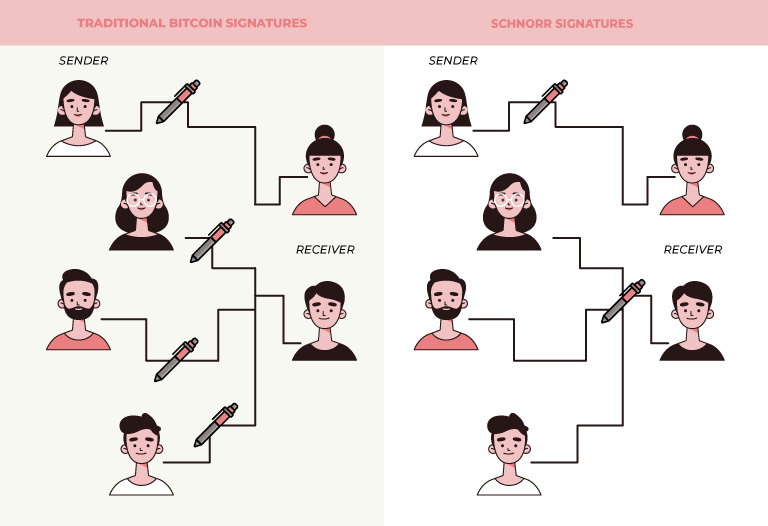
Table of Contents
ToggleFirst, let’s understand the relationship between Bitcoin and EDCSA.
Bitcoin has been the quintessential giant in the world of cryptocurrencies for more than 12 years. But that doesn’t mean that Bitcoin hasn’t changed over that time.
Like Ethereum, Bitcoin is a project with a blockchain that constantly needs to include improvements to enhance certain aspects.
Currently one of the existing difficulties within Bitcoin, goes hand in hand with the ECDSA Signature. Respectively, ECDSA is the digital signature algorithm that Satoshi Nakamoto decided to use for Bitcoin.
Of course, it is a tool that is currently used to sign the transactions you are making within the network.
In this way, after specifying that you want to transfer 3 BTC to your colleague Alex, you confirm that you performed this operation. To do this, you use a private key that functions as your digital signature.
From this, a public key is generated that miners can access to verify that the information is correct and validate your transaction.
Instead, what if the BTC you want to transfer are not only yours, but you have a multisig or multisignature wallet with other colleagues?
Consequently, for that single Bitcoin transaction, a specific number of signatures (N) are required to authorize it, following the M-of-N scheme.
Of course, that depends on whether, in an agreement, they established who would be the main signatories, whether Juliet and you or Vincent and Juliet, and so on.
Anyway, the important thing is that everyone must sign for it to be done, which extends the delay time.
However, can you imagine an algorithm in which a single signature replaces all signatures and is totally secure?
That’s exactly what we’ll talk about today, the Schnorr signatures, also known as one more step towards the future of an enhanced Bitcoin network. Let’s see what it’s all about!

What are Schnorr signatures?
Schnorr signatures is a signature scheme that allows a set of signatures to be substituted into a single signature, when they all come from the same input.
Basically, it creates a single signature for all parties involved, which facilitates multi-signature transactions.
First, this digital signature scheme was proposed and patented in 1991 by German cryptographer Klaus-Peter Schnorr.
Therefore, it is older than Bitcoin’s current signature algorithm. Now, you may wonder why it was not included from the beginning in Bitcoin?
The answer lies in the fact that the patents would expire only in 2008, when Nakamoto introduced Bitcoin to the world.
However, this algorithm was not standardized and was not widely used, unlike the proposed elliptic curve digital signature.
However, in 2018, the situation changed with the draft that Blockstream engineer Pieter Wuille included in the change request for a soft fork or soft fork.
His draft contained the proposal of what a Schnorr signature scheme would look like in Bitcoin.
Finally, in January 2020 it obtained the number BIP340, which describes the technical definition of the Schnorr signature in Bitcoin.
In all these years, it has been a matter of debate, which culminated in a unanimous decision in favor of the Schnorr and Taproot firms by the miners (with 90% agreement).
Regarding its activation, it will start working in November this year, activating automatically at block height 709,632. At the moment, it is visualized as the first update Bitcoin will see for four years.
How does it work?
To put it in simple terms, let’s go back to the example.
With the Schnor signatures, Vincent’s and Juliet’s signatures will automatically become one, as if the signatures were combined.
In this way, the observer or miner will not be able to link a signature to a specific person or number of persons.
In particular, pretend that if they made a cake, Vincent and Juliet would participate in the preparation process and deliver a single cake.
Consequently, we do not know who beat the eggs, who spread the cream, and so on, which is generated quickly by the algorithm.
After the Schnorr signature is placed, the observer will validate that the transaction has been confirmed and the 3 BTC will be transferred to Alex.

Finally, what are your advantages over ECDSA?
-
- The Schnnor signature scheme, incorporated in Bitcoin BIP340, provides greater privacy and scalability of transactions.
- It combines signatures, so it does not occupy so much space on the blockchain. This reduces transaction size and fees.
- It reduces bandwidth usage and helps transactions to be validated quickly.
- It hinders the use of wallet or fingerprint identification technology, which strengthens the anonymity and security of your information.
So much for our journey.
If you are interested in reading more articles associated with the news of the crypto universe and its basic concepts, you can click on the topics below.
If instead, you want to support the new Bitcoin updates, you can buy BTC securely and quickly from our website.
See you next time!







